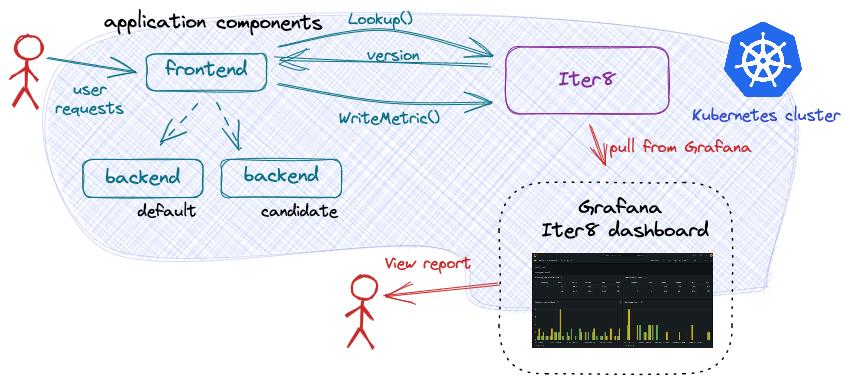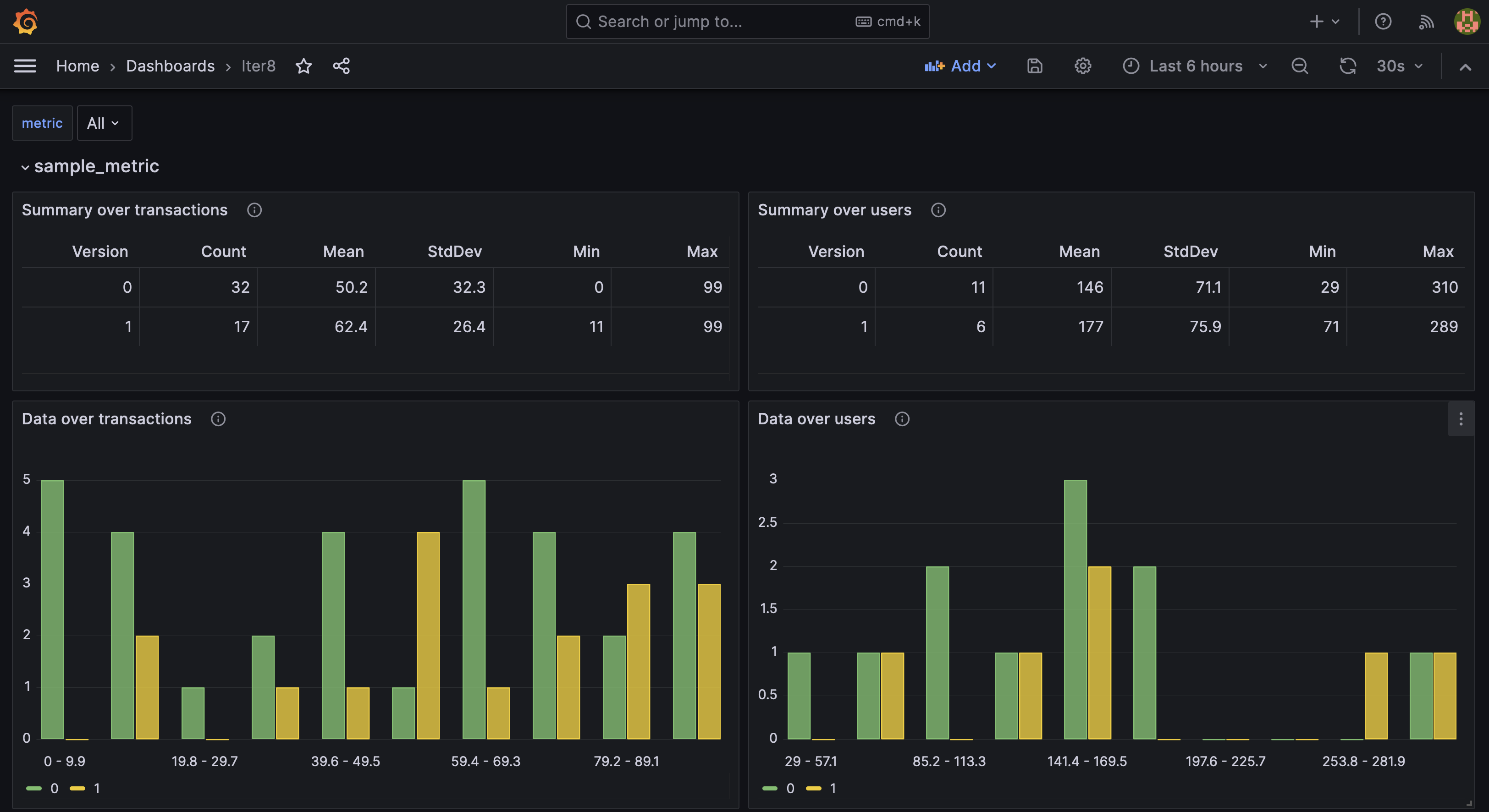A/B Testing with the Iter8 SDK¶
This tutorial describes how to do A/B testing of a backend component using the Iter8 SDK.

Before you begin
- Ensure that you have a Kubernetes cluster and the
kubectlandhelmCLIs. If using a local cluster (for example, Kind or Minikube), we recommend providing the cluster with at least 16GB of memory. - Have Grafana available. For example, Grafana can be installed on your cluster as follows:
kubectl create deploy grafana --image=grafana/grafana kubectl expose deploy grafana --port=3000
Install the Iter8 controller¶
Iter8 can be installed and configured to watch resources either in a single namespace (namespace-scoped) or in the whole cluster (cluster-scoped).
helm install --repo https://iter8-tools.github.io/iter8 --version 1.1 iter8 controller
helm install --repo https://iter8-tools.github.io/iter8 --version 1.1 iter8 controller \
--set clusterScoped=true
For additional install options, see Iter8 Installation.
Deploy the sample application¶
A simple sample two-tier application using the Iter8 SDK is provided. Note that only the frontend component uses the Iter8 SDK. Deploy both the frontend and backend components of this application as described in each tab:
Install the frontend component using an implementation in the language of your choice:
kubectl create deployment frontend --image=iter8/abn-sample-frontend-node:0.17.3
kubectl expose deployment frontend --name=frontend --port=8090
kubectl create deployment frontend --image=iter8/abn-sample-frontend-go:0.17.3
kubectl expose deployment frontend --name=frontend --port=8090
The frontend component is implemented to call Lookup() before each call to the backend component. The frontend component uses the returned version number to route the request to the recommended version of the backend component.
Release an initial version of the backend named backend:
cat <<EOF | helm upgrade --install backend --repo https://iter8-tools.github.io/iter8 release --version 1.1 -f -
environment: deployment
application:
port: 8091
versions:
- metadata:
name: backend
image: iter8/abn-sample-backend:0.17-v1
EOF
Generate load¶
In one shell, port-forward requests to the frontend component:
kubectl port-forward service/frontend 8090:8090
curl -s https://raw.githubusercontent.com/iter8-tools/docs/v0.18.3/samples/abn-sample/generate_load.sh | sh -s --
The load generator and sample frontend application outputs the backend that handled each recommendation. With just one version is deployed, all requests are handled by backend-0. In the output you will see something like:
Recommendation: {"Id":19,"Name":"sample","Source":"backend-74ff88c76d-nb87j"}
Deploy candidate¶
A candidate version of the backend component can be deployed simply by adding a second version to the list of versions:
cat <<EOF | helm upgrade --install backend --repo https://iter8-tools.github.io/iter8 release --version 1.1 -f -
environment: deployment
application:
port: 8091
versions:
- metadata:
name: backend
image: iter8/abn-sample-backend:0.17-v1
- metadata:
name: backend-candidate-1
image: iter8/abn-sample-backend:0.17-v2
EOF
While the candidate version is deploying, Lookup() will return only the version index number 0; that is, the first, or primary, version of the model. Once the candidate version is ready, Lookup() will return both 0 and 1, the indices of both versions, so that requests can be distributed across both versions.
Once both backend versions are responding to requests, the output of the load generator will include recommendations from the candidate version. In this example, you should see something like:
Recommendation: {"Id":19,"Name":"sample","Source":"backend-candidate-1-56cb7cd5cf-bkrjv"}
Compare versions using Grafana¶
Inspect the metrics using Grafana. If Grafana is deployed to your cluster, port-forward requests as follows:
kubectl port-forward service/grafana 3000:3000
Open Grafana in a browser by going to http://localhost:3000 and login. The default username/password are admin/admin.
Add a JSON API data source default/backend with the following parameters:
- URL:
http://iter8.default:8080/abnDashboard - Query string:
namespace=default&application=backend
Create a new dashboard by import. Copy and paste the contents of the abn Grafana dashboard into the text box and load it. Associate it with the JSON API data source above.
The Iter8 dashboard allows you to compare the behavior of the two versions of the backend component against each other and select a winner. Since user requests are being sent by the load generation script, the values in the report may change over time. The Iter8 dashboard will look like the following:

Once you identify a winner, it can be promoted, and the candidate version deleted.
Promote candidate¶
To promote the candidate version (backend-candidate-1), re-release the application, updating the image of the primary (the first) version to use the image of the candidate version and remove the candidate version:
cat <<EOF | helm upgrade --install backend --repo https://iter8-tools.github.io/iter8 release --version 1.1 -f -
environment: deployment
application:
port: 8091
versions:
- metadata:
name: backend
image: iter8/abn-sample-backend:0.17-v2
EOF
Calls to Lookup() will now recommend that all traffic be sent to the new primary version backend (currently serving the promoted version of the code).
The output of the load generator will again show just backend_0:
Recommendation: {"Id":19,"Name":"sample","Source":"backend-74ff88c76d-nb87j"}
Cleanup¶
Delete the sample application:
kubectl delete svc/frontend deploy/frontend
helm delete backend
Uninstall the Iter8 controller:
helm delete iter8
For additional uninstall options, see Iter8 Uninstall.
If you installed Grafana, you can delete it as follows:
kubectl delete svc/grafana deploy/grafana
Congratulations! 